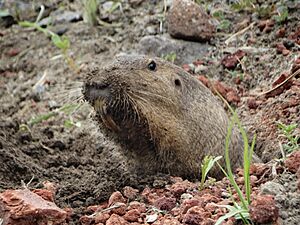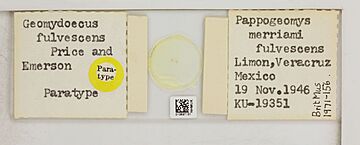Oriental Basin pocket gopher facts for kids
Quick facts for kids Oriental Basin pocket gopher |
|
|---|---|
 |
|
| Conservation status | |
| Scientific classification | |
| Genus: |
Cratogeomys
|
| Species: |
fulvescens
|
| Synonyms | |
|
|
The Oriental Basin pocket gopher (Cratogeomys fulvescens) is a type of pocket gopher. These small, burrowing rodents are found only in Mexico. This species was first described in 1895 by a scientist named Clinton Hart Merriam.
For a while, scientists thought it was just a subspecies of another gopher, Merriam's pocket gopher. But now, after more studies, it is considered its own unique species again. The IUCN Red List says this gopher is a species of least concern. This means it is not currently at risk of disappearing.
Contents
What Does It Look Like?
The Oriental Basin pocket gopher is a medium-sized gopher for its group, called Cratogeomys. Males are usually bigger than females. Adult males weigh about 250 to 550 grams (0.5 to 1.2 pounds). Adult females weigh about 250 to 350 grams (0.5 to 0.7 pounds).
Its fur is a mix of yellowish-brown and black-tipped hairs, making it look "grizzled." Its belly fur is lighter than its back fur. The gopher's skull is small for its group, usually less than 26 millimeters (about 1 inch) wide. It has 20 teeth in total. Each of its upper front teeth has a special groove along the front. The gopher's total body length, from nose to tail, is about 290 to 350 millimeters (11 to 14 inches).
Where Does It Live?
This gopher lives only in a small area in the southern part of Mexico. Its home is in the Oriental Basin, which is part of the Trans-Mexican Volcanic Belt. You can find it in the Mexican states of Puebla, Tlaxcala, and Veracruz.
It lives at high elevations, usually between 2,300 and 2,700 meters (about 7,500 to 8,900 feet) above sea level. The first place this gopher was officially found was near a city now called Ciudad Serdán in Puebla.
How Scientists Study It
The American zoologist Clinton Hart Merriam first described the Oriental Basin pocket gopher in 1895. He studied eleven gopher specimens from Puebla and Veracruz to write his description.
For many years, some scientists thought this gopher was just a subspecies of another gopher. But in 2005, a new study looked at the gopher's genes and body features. This study showed that the Oriental Basin pocket gopher is indeed its own separate species.
Scientists do not currently recognize any different types (subspecies) of this gopher. However, one subspecies was described in 1934. It was sometimes called the "yellow pocket gopher."
The first official specimens of this gopher are kept in the U.S. National Museum of Natural History in Washington, D.C. These specimens include the gopher's preserved skin and its skull.
The scientific name fulvescens comes from a Latin word meaning "yellowing." This refers to its yellowish fur. The common name, Oriental Basin pocket gopher, tells us where it lives in Mexico. In Spanish, its common name is gran tuza de la Cuenca de Oriental.
Biology and Life Cycle

The Oriental Basin pocket gopher eats rhizomes, bulbs, and roots. These are all parts of plants that grow underground.
Scientists have seen pregnant gophers from December through February. Since they haven't seen pregnant gophers in July, it's thought they only have one litter of babies each year.
This gopher can host tiny creatures called parasites. Two types of chewing lice live on this gopher. Fleas have also been found on them. A type of nematode (a tiny worm) can also be a parasite of this gopher.
Conservation Status
The IUCN Red List has listed the Oriental Basin pocket gopher as a least-concern species. This means it is not currently considered endangered. Mexico's environmental agency, SEMARNAT, also did not include it on its 2010 list of threatened mammals.
Even though the area where it lives is smaller than 20,000 square kilometers (about 7,700 square miles), scientists believe it is common. It can also adapt to different environments. However, some of its habitat is being lost because of human development. These gophers have sometimes been found as roadkill on highways.
Some scientists suggest more studies are needed to check on its conservation status. This is especially true because its home range is smaller than other Mexican pocket gophers. The Oriental Basin pocket gopher has been seen on farms. It can sometimes be considered a pest because it damages crops like wheat, corn, and and beans.


